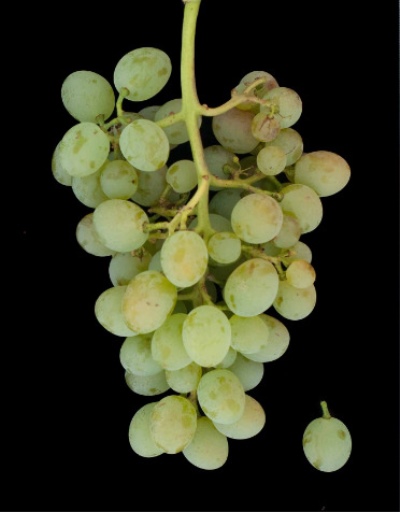
- Authors: Ukraine
- Appointment: universal
- Berry color: yellowish green
- Taste: simple
- With bones: Yes
- Ripening period: late
- Ripening period, days: 160-170
- Frost resistance, ° C: -18
- Name synonyms: White long, Bigas Kokur, Long, Kokur de Zante
- Bunch weight, g: 160-200
The Kokur white variety is a local or, in other words, "aboriginal" variety of the Crimean grapes. Late in maturity, not resistant to frost, has an average immunity to fungal diseases, and has a high yield. Used for desserts, making strong and table wines, as well as champagne and cognac.
Other names White long, Bigas Kokur, Kokur de Zante.
Breeding history
According to the version of the Russian scientist P.P. Kepner, White Kokur was brought to the Crimea by the Greeks from the island of Corfu in the XII-XIV centuries.
Geography of distribution
It is grown in the southeast and southwest of Crimea; it is also widespread in the Don River basin.
Description
The bushes are tall, the leaves are large and curly, deeply dissected, five-lobed can be seven- and nine-lobed, funnel-shaped. The leaf plate is smooth, light green, with slight pubescence in the lower part. Green shoots are distinguished by intensive growth, reach a length of 2.5 meters, strongly thicken the plant. Inflorescences of medium size, moderate density, with two developed upper branches. Ripening of shoots is high.
Ripening period
From budding to ripening of berries, 160-170 days pass, a little more under unfavorable conditions. Harvested from early August to early September.
Bunches
The grapes have small clusters weighing 160-200 g, with good care it reaches 350 g. Conical, sometimes cylindrical, with strongly developed blades, not very dense.
Berries
Fruits are large, oval, yellow-green, when overripe they become light amber in color with a slight waxy bloom. The skin is thin, the pulp is very juicy, loose - melting with a special aroma. Contains 2-3 small seeds. Peas are insignificant.
Taste
Pleasant harmonious grape, the optimal combination of sweetness and acidity. Contains 22-24% sugar, acids - 7-8 g / l.
Yield
Characterized as tall but inconsistent. On average 3-4 kg per bush.


Growing features
It can suffer from spring frosts, therefore it is recommended not to remove the shelter early, making holes for ventilation. In climates with recurrent frosts, it is better to cover at night. It tolerates a lack of moisture well.
The vines must be tied up, as they break off easily.
Can be grown in a greenhouse, the height of the structure is at least 2 m.
Landing
It is necessary to plant in autumn, in October, before the onset of cold weather, or in spring, from early April to mid-May. The variety prefers elevated, light and warm places, in the lowlands it is strongly affected by fungal diseases. They are planted from the south or west side of buildings, or a structure is erected to protect it from the wind. Grows well on rocky and sandy, sandy loam soils. The close location of groundwater oppresses the plant.
An interval of 2.5 meters is made between the seedlings. They dig a hole 80 cm deep and wide, put drainage on the bottom, pour a mound - a mixture of peat, humus and sand (1: 1: 1), add ammonium nitrate and potash fertilizers, pour 2 liters of water. After half an hour, a bush is placed on the hill, covered with a mixture of peat and sand, watered abundantly, mulched. When planting seedlings in a row, dig a trench.

Pollination
The flowers are bisexual, they pollinate themselves; with additional pollination, the yield increases up to 50%. Use the pollen of the appropriate pollinator varieties. Can be a good pollinator for other grape varieties.
Pruning
Long pruning is recommended, since the most fruitful shoots are located above 4 knots. To obtain a regular harvest, cut into 5-6 eyes. It is advised to form on a 2-3-sleeve system. Often grown on arched structures. In the first year after planting, do not prune.

Watering
The first watering is carried out after removing the winter insulation. 1 bush requires 40 liters of water. The second time is watered a week before flowering, the next - after the flowers have fallen off. Do not watered during the ripening period. The last irrigation is done 7 days before the shelter for the winter.


Top dressing
The first is carried out in the spring after removing winter insulation with dry nitrogen fertilizers, potassium and superphosphate. They are introduced into a specially dug groove, which is then sprinkled. Before flowering for 7-10 days, they are fed with a solution of manure or manure with potassium-phosphate additives.
Foliar top dressing with the preparations "Aquarin", "Kemira", "Novofert" is obligatory.
Frost resistance and the need for shelter
The variety is not winter-hardy, but the lashes covered for the winter do not freeze. Young vines are also closed in regions with a warm climate. The lashes are laid on boards, covered with spunbond or agrospan. In colder areas - still spruce branches and sprinkle with soil.

Diseases and pests
Strongly affected by powdery mildew, gray rot, mildew. Recommended spraying with Bordeaux liquid, fungicides. Medium resistance to pests - leaf roll. For prevention, they are treated with insecticides.

If a grape is exposed to any disease or insect, this always affects its appearance.
Storage
Berries with intact waxy bloom are stored for up to 2 months in a cool, dry place. The bunches can be transported in small wooden boxes when stacked in a compact, even manner.











































































